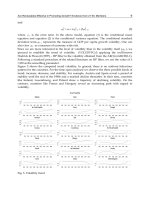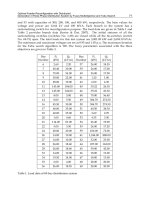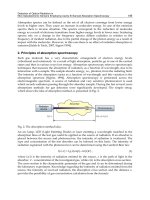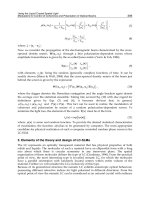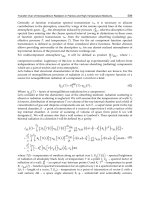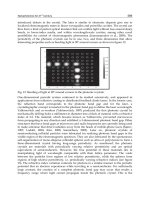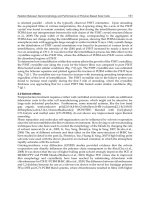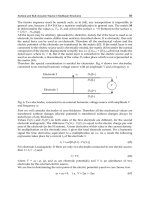MIMO Systems Theory and Applications Part 5 docx
Bạn đang xem bản rút gọn của tài liệu. Xem và tải ngay bản đầy đủ của tài liệu tại đây (543.54 KB, 35 trang )
0 5 10 15 20 25 30
1
2
3
4
5
6
7
8
9
10
Eb/No[dB]
Rate[bit/s/Hz/transmit antenna]
MMSE SIC
N
r
=4
N
r
=5
N
r
=6
N
r
=7
N
r
=8
Fig. 5. Information rate per transmit antenna averaged over random channels for MMSE-SIC
for a fixed N
t
= 4andvaryingN
r
.
0 5 10 15 20 25 30
0
1
2
3
4
5
6
7
8
9
Eb/No[dB]
Rate[bit/s/Hz/transmit antenna]
Block MMSE
N
r
=4
N
r
=5
N
r
=6
N
r
=7
N
r
=8
Fig. 6. Information rate per transmit antenna averaged over random channels for block
MMSE for a fixed N
t
= 4andvaryingN
r
.
129
Another Interpretation of Diversity Gain of MIMO Systems
0 5 10 15 20 25 30
0
1
2
3
4
5
6
7
8
9
Eb/No[dB]
Rate[bit/s/Hz/transmit antenna]
MMSE SIC
N
t
=4
N
t
=5
N
t
=6
N
t
=7
N
t
=8
Fig. 7. Information rate per transmit antenna averaged over random channels for MMSE-SIC
for a fixed N
r
= 8andvaryingN
t
.
0 5 10 15 20 25 30
0
1
2
3
4
5
6
7
8
Eb/No[dB]
Rate[bit/s/Hz/transmit antenna]
Block MMSE
N
t
=4
N
t
=5
N
t
=6
N
t
=7
N
t
=8
Fig. 8. Information rate per transmit antenna averaged over random channels for block
MMSE for a fixed N
r
= 8andvaryingN
t
.
130
MIMO Systems, Theory and Applications
which highlight the tradeoff between capacity and bandwidth efficiency (and multiplexing
gain). All these results hold for any kind of i.i.d. channel regardless of the channel pdf and is
valid at any SNR. Numerical simulations corroborated our analysis.
7. References
Alamouti, S. M. (1998). A simple transmit diversity for wireless communications, IEEE Journal
on Selected Areas in Communications 16(8): 1451–1458.
Caire, G. and Shamai, S. (1999). On the capacity of some channels with channel state
information, IEEE Transactions on Information Theory pp. 2007–2019.
Catreux, S., Greenstein, L. J. and Erceg, V. (2003). Some results and insights on
the performance gains of MIMO systems, IEEE Journal on Selected Areas in
Communications 21(5): 839–847.
Chiani, M., Win, M. Z. and Zanella, A. (2003). On the capacity of spatially correlated MIMO
rayleigh-fading channels, IEEE Transactions on Information Theory 49(10): 2363–2371.
Foschini, G. J. (1996). Layered space-time architecture for wireless communication in a fading
environment when using multi-element antennas, Bell Labs Tech. J. 1(2): 41–59.
Foschini, G. J., Golden, G., Valenzuela, R. and Wolniansky, P. (1999). Simplified processing
for high spectral efficiency wireless communication employing multi-element arrays,
IEEE Journal on Selected Areas in Communications 17(11): 1841–1852.
Goldsmith, A., Jafar, S. A., Jindal, N. and Vishwanath, S. (2003). Capacity limits of MIMO
channels, IEEE Journal on Selected Areas in Communications 21(5): 684–702.
Kay, S. M. (1993). Fundamentals of Statistical Signal Processing,Vol.1,PrenticeHall.
Larsson, E. G. and Stoica, P. (2003). Space-time block coding for wireless communications,
Cambridge University Press.
Ma, X. and Giannakis, G. B. (2003). Full-diversity full-rate complex-field space-time coding,
IEEE Transactions on Signal Processing 51(11): 2917–2930.
Marzetta, T. L. and Hochwald, B. M. (1999). Capacity of a mobile multiple-antenna
communication link in rayleigh flat fading, IEEE Transactions on Information Theory
45(1): 139–157.
Narasimhan, R. (2003). Spatial multiplexing with transmit antenna and constellation
selection for correlated MIMO fading channels, IEEE Transactions on Signal Processing
51(11): 2829–2838.
Ohno, S. and Teo, K. A. D. (2007). Universal BER performance ordering of MIMO systems
over flat channels, IEEE Transactions on Wireless Communications 6(10): 3678–3687.
Smith, P. J., Roy, S. and Shafi, M. (2003). Capacity of MIMO systems with semicorrelated flat
fading, IEEE Transactions on Information Theory 49(10): 2781–2788.
Tarokh, V., Jafarkhani, H. and Calderbank, A. R. (1999). Space-time block coding for wireless
communications: performance results, IEEE Trans. Communication 17(3): 451–460.
Telatar, I. E. (1999). Capacity of multiple-antenna Gaussian channels, Eur. Tran s. Tel.
pp. 585–595.
Tse, D. and Viswanath, P. (2005). Fundamentals of wireless communication, Cambridge University
Press.
Winters, J. H., Salz, J. and Gitlin, R. D. (1994). The impact of antenna diversity on the
capacity of wireless communication systems, IEEE Transactions on Communications
42(234): 1740–1751.
131
Another Interpretation of Diversity Gain of MIMO Systems
Xin, Y., Wang, Z. and Giannakis, G. B. (2003). Space-time diversity systems based on linear
constellation precoding, IEEE Transactions on Wireless Communications 2(2): 294–309.
Zheng, L. and Tse, D. N. C. (2003). Diversity and multiplexing: a fundamental tradeoff in
multiple-antenna channels, IEEE Transactions on Information Theory 49(5): 1073–1096.
132
MIMO Systems, Theory and Applications
0
Rate-Adaptive Information Transmission
over MIMO Channels
Marco Zoffoli, Jerry D. Gibson and Marco Chiani
Fellow, IEEE
1. Introduction
In the context of wireless communication, a Multiple-Input Multiple-Output (MIMO) system
is a system that employs multiple antennas both at the transmitter and receiver. The first
theoretical analysis of MIMO systems were developed by Winters (1987), Foschini (1996) and
Telatar (1999), and since then there have been many research efforts on this subject. What
mainly makes MIMO systems interesting is their potential ability to achieve an increase in
system capacity or in link reliability without requiring additional transmission power or
bandwidth (Goldsmith, 2005).
In this work, we focus on the utilization of MIMO systems for the lossy transmission of
source information. In particular, we want to compare several different strategies for the
transmission of a zero mean Gaussian source over Rayleigh-fading MIMO channels, assuming
rate-adaptive source encoding. The MIMO transmission strategies are based on techniques
such as Repetition coding (REP), Time Sharing (TS), the Alamouti scheme (ALM) and Spatial
Multiplexing (SM) (Alamouti, 1998; Tse & Viswanath, 2006).
Depending on its characteristics, each strategy will be used either for the transmission of a
Single Description (SD) or the transmission of a Multiple Description (MD) representation of
this source. In SD coding, a single stream of information describing the source is transmitted
over a single channel. In MD coding (Gamal & Cover, 1982), the source is represented
using two different descriptions that are transmitted over two independent channels. If both
descriptions are correctly received, they can be combined together at the receiver to obtain a
reconstruction of the source at a certain quality. If only one of the two descriptions is correctly
received, a reconstruction of the source is still possible but at a lower quality.
We consider adaptive source encoding, where the rate is adapted to follow the slow variations
of the channel (due e.g. to shadowing and path loss) or the fast variations of the channel (due
to fading), leading to two scenarios that we call fixed-outage and zero-outage, respectively.
In the first case, we consider Gaussian source transmission over MIMO systems when CSI is
not available at the transmitter. In this scenario, since the transmitter does not have knowledge
of channel state information (CSI), it does not know the instantaneous rate supported by
the channel, i.e. its capacity, and hence it is not able to adapt the source coding rate to the
channel conditions to ensure the decoding of the information at the receiver with an arbitrarily
small probability of error. Instead, it encodes and transmits the source information using a
rate chosen to achieve a selected outage probability. When the channel does not support the
6
transmission of information at the chosen coding rate, data are lost and the system experiences
an outage. We call this the fixed-outage rate-adaptive approach.
In the second scenario (zero-outage rate-adaptive), we consider the different MIMO strategies
under the assumption of perfect CSI at the transmitter. In this case, the transmitter is able to
follow the variations of the channel by adapting the source coding rate to the instantaneous
capacity, since it is aware of the particular channel realization in every time instant. In
such a situation there is no outage since the source rate is always adapted to achieve the
instantaneous channel capacity (Choudhury & Gibson, 2007). This observation has a direct
impact on the usefulness of the TS strategies in the zero-outage scenario. These strategies
employ a time sharing approach to the transmit antennas to create independent channels from
our MIMO system (Zoffoli et al., 2008a). These independent channels are then used to provide
path diversity by transmitting multiple description representations of the source over them.
However, path diversity is useful only if the channels are unreliable, i.e. if they suffer outages.
For this reason, in the zero-outage scenario we do not consider the TS strategies.
The different strategies for both the fixed-outage and the zero-outage rate adaptation
approaches are described in the following sections, where we also evaluate their performance
by studying the statistics of the distortion at the receiver.
In the presence of outage, it is usually assumed either implicitly or explicitly that
retransmissions will be used for data scheduled to be transmitted during an outage; indeed,
choosing an operational outage rate may be associated with an acceptable retransmission
rate. Although retransmissions are the natural response to outage for data sources, relying
on retransmissions may or may not be appropriate for compressed voice or video for several
reasons. First, it is not unusual to rely on packet loss concealment for voice and video up to
some non-trivial packet loss rate. Second, it may be more desirable not to retransmit for voice
and video in order to reduce latency or to maximize access point throughput. As a result, the
suitable measure of performance for lossy source coding of voice and video is the average
distortion of the source reproduced at the receiver. Average distortion is also the appropriate
performance indicator for the zero outage rate case, since we are adapting the source coding
rate to the instantaneous capacity of the channel, and it is desired to determine the reproduced
quality of the source delivered to the user. Therefore, for our work here, we choose the mean
squared error (MSE) fidelity criterion.
In Section II, we present the basic assumptions and set up the particular MIMO problems we
are addressing. Section III contains the development of the fixed outage rate adaptive source
encoding scenarios we examine, including the repetition strategy and single description
source coding, the time sharing strategy and the three multiple descriptions source coding
methods (no excess marginal rate, no excess joint rate, and optimized multiple descriptions
source coding), the Alamouti strategy with single description source coding, and spatial
multiplexing with single description source coding. Zero outage rate adaptive source
encoding, wherein CSI is available at the transmitter and the source coding is adjusted to
match the instantaneous capacity, is described in Section IV, including the developments
and derivations of the distributions of the reconstructed source distortion for the repetition,
Alamouti, and spatial multiplexing strategies. Extensive results for each of the methods and
comparisons of the results are presented in Section V, while Section VI summarizes the
conclusions from the work.
134
MIMO Systems, Theory and Applications
2. Assumptions and preliminaries
Our main goal is to discuss how MIMO techniques impact on adaptive source encoding.
Although most of our results can be easily extended to cover the general N
t
× N
r
MIMO
channel case, for the sake of simplicity we consider the frequency-flat 2
× 2 MIMO channel.
The system is characterized by the channel matrix H, having the form
H
=
h
11
h
12
h
21
h
22
Each entry h
ij
of the channel matrix H represents the gain of the channel between the j-th
transmit antenna and i-th receive antenna. These channels are assumed to be independent,
random and with very slow Rayleigh fading. The h
ij
are then i.i.d. complex Gaussian random
variables with zero mean and unit variance, which remain constant over the transmission of
a large number of symbols. Under these assumptions, the squared magnitude of the channel
gains can be written as
|h
ij
|
2
=
1
2
x
ij
, i, j = 1, 2 (1)
where the x
ij
are random variables distributed according to a chi-square distribution with 2
degrees of freedom (Hogg & Craig, 1970). Perfect CSI, i.e. knowledge of H, is assumed to be
always available at the receiver, while the transmitter has a full or partial CSI depending on
the scenario, as will be discussed later.
The total transmitted power by the transmit antennas is constrained to P
t
. If both transmit
antennas are transmitting simultaneously, each antenna will transmit with equal power P
t
/2,
while, if only one antenna is transmitting at a given time, it can make use of full transmit
power P
t
. The noise at the receiver is AWGN, with i.i.d. statistics and the same average power
N at each receive antenna.
We denote with γ
ij
the instantaneous Signal to Noise Ratio (SNR) of the signal transmitted by
the j-th antenna and received by the i-th antenna. Thus,
γ
ij
=
P
t
N
|h
ij
|
2
=
¯
γ
|h
ij
|
2
, i = 1, 2 (2)
if only the j-th antenna is transmitting at a given time, and
γ
ij
=
P
t
2N
|h
ij
|
2
=
¯
γ
2
|h
ij
|
2
, i, j = 1, 2 (3)
if both antennas are transmitting at the same time.
H
Fig. 1. 2×2 MIMO model.
The source is assumed to be a zero-mean memoryless Gaussian source with a variance
normalized to unity. The system bandwidth is also assumed to be normalized to unity.
135
Rate-Adaptive Information Transmission over MIMO Channels
In the following, we will denote with
¯
γ the ratio P
t
/N and with Γ(z) and Γ(a, z), respectively,
the gamma function and the incomplete gamma function (Hogg & Craig, 1970). We will also
denote with χ
2
k
the distribution of a chi-square random variable with k degrees of freedom,
with F
(k)
χ
(z) its CDF and with
f
(k)
χ
(z)=
1
Γ
k
2
2
k
2
z
k−2
2
e
−
z
2
its probability density function (PDF) (Hogg & Craig, 1970).
3. Fixed-Outage rate-adaptive source encoding (FORA)
In a wireless channel, due to multipath propagation and users’ mobility, the capacity is
varying in time. In this section we assume that the source encoder knows only the statistical
distribution of the wireless channel mutual information, and that it adapts its rate accordingly.
The source encoder rate is chosen to produce a certain outage probability, determined to
minimize the distortion at the received end. This could be assumed a slow-adaptive technique,
since the source encoder rate will follow the variations of the channel statistics due, for
instance, to shadowing and path loss changes.
3.1 Repetition
The REP strategy is based on repetition coding (Tse & Viswanath, 2006). The basic idea is to
transmit the same symbol over the two transmit antennas in two consecutive time slots. In
each time slot, only one of the two transmit antennas is used for transmission, while the other
antenna is turned off.
Thus, in the first time slot the symbol S
1
is transmitted on the first transmit antenna and it
is observed by the receiver through the two channels with gains h
11
and h
21
. In the second
time slot, the same symbol S
1
is transmitted on the second transmit antenna and it is observed
by the receiver through the two channels with gains h
12
and h
22
. A Maximal Ratio Combiner
(MRC) (Goldsmith, 2005) is then used at the receiver to optimally combine the four signals
received by the two receive antennas in the two different time slots.
The instantaneous SNR γ of the signal at the output of the MRC is given by the sum of the
instantaneous SNRs γ
ij
of its input signals (Goldsmith, 2005), that are given by Eq. (2)
γ
=
2
∑
i,j=1
γ
ij
=
¯
γ
2
∑
i,j=1
|h
ij
|
2
(4)
In this way, a single channel is obtained from the four independent channels available in our
MIMO system. This strategy is then suitable for the transmission of a SD representation of the
source.
The instantaneous capacity of this single channel in [bits/channel use] is given by (Goldsmith,
2005)
C
=
1
2
log
2
1
+ γ
=
1
2
log
2
1
+
¯
γ
2
∑
i,j=1
|h
ij
|
2
(5)
where the factor 1/2 arises because we are transmitting the same symbol over two consecutive
time slots.
136
MIMO Systems, Theory and Applications
The source coding rate R
REP
of the SD coder is chosen to be equal to the outage capacity at a
given value for the outage probability P
out
, i.e. it is chosen such that
Pr
C
< R
REP
= P
out
Thus, with probability 1 − P
out
the system is not in outage, which means that it can support
the transmission at a rate R
REP
with an arbitrarily small probability of error, since its capacity
is higher than R
REP
(Cover & Thomas, 1991). In such case, the receiver is able to reconstruct
the source information with a distortion D
1
equal to (Cover & Thomas, 1991)
D
1
= 2
−2R
REP
If the system results in outage, which happens with probability P
out
, the receiver is not able
to correctly decode the transmitted information with an arbitrarily small probability of error
and achieves a distortion equal to 1.
The expected distortion D at the receiver is then
D
=(1 − P
out
)D
1
+ P
out
The outage rate R
out
REP
, defined as the average rate correctly received over many transmission
bursts (Goldsmith, 2005), is given by
R
out
REP
=(1 − P
out
)R
REP
3.2 Time sharing - multiple description (TS-MD)
In this strategy a TS approach is adopted to obtain two independent channels from the MIMO
system. The idea behind this strategy is to transmit two different symbols over the two
transmit antennas in two consecutive time slots. In each time slot, only one of the two transmit
antennas is used for transmission, while the other antenna is turned off. Thus, in the first time
slot the first symbol S
1
is transmitted over the first antenna and it is observed by the receiver
through the two channels with gains h
11
and h
21
. In the second time slot, the second symbol
S
2
is transmitted over the second antenna and it is observed by the receiver through the two
channels with gains h
12
and h
22
. The receiver will then combine the two signals received in
the same time slot using a MRC.
Since each received signal has a SNR given by Eq. (2), the signal at the output of the MRC in
the j-th time slot has a SNR equal to (Goldsmith, 2005)
γ
j
=
2
∑
i=1
γ
ij
=
¯
γ
2
∑
i=1
|h
ij
|
2
In this way, two independent channels are effectively created in the two time slots, making
this strategy suitable for the transmission of a MD representation of the source.
The channel at the j-th time slot has an instantaneous capacity C
j
equal to (Goldsmith, 2005)
C
j
=
1
2
log
2
1
+ γ
j
=
1
2
log
2
1
+
¯
γ
2
∑
i=1
|h
ij
|
2
(6)
where the factor 1/2 arises because each channel is used only half of the time.
137
Rate-Adaptive Information Transmission over MIMO Channels
The side description rate R
MD
/2, which equals the transmitted rate over each channel, is
chosen to be equal to the outage capacity for a given P
out
, i.e. is chosen such that
Pr
C
j
<
R
MD
2
= P
out
The expected distortion D at the receiver is then given by
D
=(1 − P
out
)
2
D
0
+ 2P
out
(1 − P
out
)D
1
+ P
2
out
(7)
where D
0
and D
1
are the distortions achieved by the receiver when observing, respectively,
both descriptions or only one of the two descriptions.
Depending on the type of MD coder used, D
0
and D
1
can have different expressions (Balam
& Gibson, 2006) and different TS-MD strategies can be obtained. The No Excess Marginal
Rate coder (MD-NMR) (Balam & Gibson, 2006) is employed in the TS-MD-NMR strategy.
The side descriptions are then rate distortion optimal and the distortions have the following
expressions (Balam & Gibson, 2006; Effros et al., 2004)
D
0
=
2
−R
MD
2 −2
−R
MD
D
1
= 2
−R
MD
The No Excess Joint Rate coder (MD-NJR) (Balam & Gibson, 2006) is employed in the
TS-MD-NJR strategy. Here the joint description is rate distortion optimal and the distortions
have the following expressions (Balam & Gibson, 2006; Effros et al., 2004)
D
0
= 2
−2R
MD
D
1
=
1
2
1
+ 2
−2R
MD
The optimal coder (MD-OPT) (Effros et al., 2004) is employed in the TS-MD-OPT strategy.
In this case, neither the side descriptions nor the joint description is rate distortion optimal,
but they are chosen to minimize the expected distortion D in Eq. (7) for a given P
out
. The
distortions D
0
and D
1
are given by the following expression (Balam & Gibson, 2006; Effros
et al., 2004)
D
0
, D
1
=
a,
1
+ a
2
−
1 −a
2
1 −
2
−2R
MD
a
with
a
∈
2
−2R
MD
,
2
−R
MD
2 −2
−R
MD
Thus, the MD-OPT coder chooses the proper value for a to minimize the expected distortion
D.
The outage rate R
out
MD
is given by
R
out
MD
=(1 −P
out
)
2
R
MD
+ 2P
out
(1 − P
out
)
R
MD
2
=(1 −P
out
)R
MD
138
MIMO Systems, Theory and Applications
3.3 Alamouti
This strategy employs the Alamouti scheme (Alamouti, 1998; Tse & Viswanath, 2006) to obtain
two independent channels from the MIMO system. Since both channels have the same gain
given by
∑
2
i,j
=1
|h
ij
|
2
(Tse & Viswanath, 2006), it is evident that it is impossible to have, for a
given realization of the channel matrix H, one channel in outage and the other not in outage,
i.e. both channels can only be simultaneously in outage or simultaneously not in outage.
1
This
strategy is then not suitable for the transmission of a multiple description representation of the
source, as also pointed out in (Effros et al., 2004). Instead, it could be used for the transmission
of a single description representation, demultiplexing it into two half-rate substreams which
are then transmitted over the two channels.
The signals at the output of the Alamouti decoder have the same instantaneous SNR γ, equal
to the sum of the SNRs of the signals on each branch (Goldsmith, 2005). Thus, from Eq. (3) we
have
γ
=
2
∑
i,j=1
γ
ij
=
¯
γ
2
2
∑
i,j=1
|h
ij
|
2
The instantaneous capacity of this system is then given by (Sandhu & Paulraj, 2000)
C = log
2
1
+ γ
= log
2
1
+
¯
γ
2
2
∑
i,j=1
|h
ij
|
2
(8)
and the source coding rate R
ALM
is chosen such that
Pr
C
< R
ALM
= P
out
The expected distortion is then
D
=(1 − P
out
)D
1
+ P
out
where D
1
is the distortion achieved by the receiver when the system is not in outage, which is
equal to (Cover & Thomas, 1991)
D
1
= 2
−2R
ALM
(9)
The outage rate R
out
ALM
is given by
R
out
ALM
=(1 − P
out
)R
ALM
3.4 Spatial multiplexing
In the SM strategy (Tse & Viswanath, 2006), a single symbol stream is first demultiplexed and
encoded into two separate and independent substreams. Each substream is then transmitted
simultaneously over each transmit antenna and, at the receiver, an optimal joint decoder is
employed for retrieving the original symbol stream.
Since this strategy requires one single symbol stream, it can only be used for the transmission
of a SD representation of the source.
1
This is true also because the transmitted rate on each channel is the same, which is the only case of
interest for us.
139
Rate-Adaptive Information Transmission over MIMO Channels
The instantaneous capacity achievable with this strategy is given by (Foschini & Gans, 1998)
C
= log
2
det
I
2
+
¯
γ
2
HH
H
(10)
where I
2
is the 2×2 identity matrix and H
H
denotes the conjugate transpose of the channel
matrix H. In a similar way as before, given the outage probability the source coding rate R
SM
is chosen such that
Pr
{C < R
SM
} = P
out
This CDF can be computed for a general MIMO channel without resorting to MonteCarlo
simulation as indicated in (Chiani, Win & Zanella, 2003). For the particular case of the 2
×2
MIMO, a simple closed form expression is derived in the Appendix.
The expected distortion D at the receiver is then
D
=(1 − P
out
)D
1
+ P
out
where
D
1
= 2
−2R
SM
(11)
is, as usual, the distortion achieved when the system is not in outage.
The outage rate R
out
SM
is given by
R
out
SM
=(1 − P
out
)R
SM
4. Zero-outage rate-adaptive source encoding (ZORA)
In this section we assume that the source encoder knows the (instantaneous) value of the
wireless channel mutual information. Thus, it encodes the source at a rate just below the
mutual information, leading to the best achievable distortion at the receiver side. Note that
this is a zero-outage strategy, that is expected to provide better results than the fixed-outage
strategy, at the cost of increased system complexity due to the need for complete CSI at the
transmitter side. Furthermore, this is a fast-adaptive technique compared to the fixed-outage,
since the rate of adaptation is determined by the variations of the channel fading.
4.1 Repetition
Since transmitter side information does not increase capacity unless transmitted power is also
adapted (Goldsmith, 2005), the capacity of this strategy in a given fading realization has the
same expression as in (5) which can be rewritten using (1) as
C
=
1
2
log
2
1
+
¯
γ
2
2
∑
i,j=1
x
ij
=
1
2
log
2
1
+
¯
γ
2
x
s
where
∑
2
i,j
=1
x
ij
= x
s
∼ χ
2
8
(Hogg & Craig, 1970).
Since the transmitter has CSI knowledge, in every time instant the source coding rate R
REP
can be adapted to achieve the instantaneous capacity C. The distortion D
r
observed at the
receiver is then (Cover & Thomas, 1991)
D
r
= 2
−2R
REP
=
1
1 +
¯
γ
2
x
s
140
MIMO Systems, Theory and Applications
which is a continuous random variable. Its expected value is
D
REP
= E
D
r
=
+∞
0
1
1 +
¯
γ
2
z
f
(8)
χ
(z)dz
=
1
48
+∞
0
z
3
2 +
¯
γz
e
−
z
2
dz
which yields
D
REP
=
1
6
·
¯
γ
−
¯
γ
2
+ 2
¯
γ
3
−e
1
¯
γ
Γ
0,
1
¯
γ
¯
γ
4
The CDF F
REP
(d) of the distortion at the receiver can be derived as
F
REP
(d)=Pr
D
r
< d
= Pr
x
s
>
2 −2d
¯
γd
= 1 −F
(8)
χ
2
−2d
¯
γd
4.2 Alamouti
This strategy (Zoffoli et al., 2008a) employs the Alamouti scheme to obtain two independent
channels from the MIMO system. These two channels are then used for the transmission of
a single description representation of the source, after demultiplexing it into two half-rate
substreams. The capacity for the ALM strategy is given by (8) that, from (1), can be expressed
as
C
= log
2
1
+
¯
γ
4
2
∑
i,j=1
x
ij
= log
2
1
+
¯
γ
4
x
s
where
∑
2
i,j
=1
x
ij
= x
s
∼ χ
2
8
(Hogg & Craig, 1970).
Using transmitter side information, the source coding rate R
ALM
can be adjusted to follow the
variations of the capacity C. Thus, the distortion at the receiver is given by (Cover & Thomas,
1991)
D
r
= 2
−2R
ALM
=
1
1
+
¯
γ
4
x
s
2
Its expected value can be evaluated as
D
ALM
= E
D
r
=
+∞
0
1
1
+
¯
γ
4
z
2
f
(8)
χ
(z)dz
=
1
6
+∞
0
z
3
(4 +
¯
γz
)
2
e
−
z
2
dz
which finally results in
D
ALM
=
2
3
·
¯
γ
¯
γ
−4
¯
γ −4
+ 4e
2
¯
γ
3
¯
γ
+ 2
Γ
0,
2
¯
γ
¯
γ
5
141
Rate-Adaptive Information Transmission over MIMO Channels
The CDF F
ALM
(d) of the distortion is
F
ALM
(d)=Pr
D
r
< d
= Pr
x
s
>
4 −4
√
d
¯
γ
√
d
= 1 −F
(8)
χ
4
−4
√
d
¯
γ
√
d
4.3 Spatial multiplexing strategy
Here, a single description of the source, i.e. a single symbol stream, is first demultiplexed and
encoded into two separate and independent substreams. Each substream is then transmitted
simultaneously over each transmit antenna and, at the receiver, an optimal joint decoder is
employed for retrieving the original symbol stream. The capacity of this strategy is given by
(10).
In the Appendix it is shown that the expected distortion for ZORA over SM MIMO system is
given by
D
SM
= −
16
¯
γ −
¯
γ
+ 2
e
2
¯
γ
Γ
0,
2
¯
γ
2
¯
γ
6
+
8
¯
γ −2e
2
¯
γ
Γ
0,
2
¯
γ
¯
γ
¯
γ
+ 2
−4
¯
γ + 1
e
2
¯
γ
Γ
0,
2
¯
γ
¯
γ
6
.
The CDF of the distortion observed at the receiver is obtained in the Appendix as
F
SM
(d)=Pr
D
r
< d
= 1 −Pr
x
1
x
2
<
1
√
d
= 1 −F
1
√
d
(12)
where
F
(z)=
2
¯
γ
3
e
4
¯
γ
z
1
e
−
2
¯
γ
x
2
·
e
−
2
¯
γ
¯
γ
2
−2
¯
γ
x
2
−1
+ 2
x
2
−1
2
−e
−
2
¯
γ
z
x
2
¯
γ
2
+ 2
¯
γ
z
x
2
− x
2
+ 2
z
x
2
− x
2
2
dx
2
5. Numerical results
5.1 Discussion for the fixed-outage strategies
We begin the discussion by comparing only the three TS-MD strategies. Then, we compare
TS-MD-OPT with the remaining three strategies.
Figure 2 compares the expected distortions achievable with the TS strategies at a fixed
¯
γ
of 10 dB. These results can be explained using the same observations we made in (Zoffoli
et al., 2008b), where we considered MD strategies over two parallel and independent fading
channels. For completeness, we now briefly restate here these conclusions.
As expected, TS-MD-OPT achieves the lowest distortions, since it is designed to minimize
Eq. (7). At low outage probabilities, both descriptions are correctly decoded most of the time
142
MIMO Systems, Theory and Applications
0 0.1 0.2 0.3 0.4 0.5 0.6 0.7 0.8 0.9 1
0
0.1
0.2
0.3
0.4
0.5
0.6
0.7
0.8
0.9
1
Outage probability
Expected distortion
TS−MD−NMR
TS−MD−NJR
TS−MD−OPT
Fig. 2. FORA: expected distortion vs. outage probability for the different TS strategies with
¯
γ
=10dB.
0 0.1 0.2 0.3 0.4 0.5 0.6 0.7 0.8 0.9 1
0
0.1
0.2
0.3
0.4
0.5
0.6
0.7
0.8
0.9
1
Outage probability
Expected distortion
REP
TS−MD−OPT
ALM
SM
Fig. 3. FORA: expected distortion vs. outage probability for the different strategies with
¯
γ =
10 dB.
143
Rate-Adaptive Information Transmission over MIMO Channels
and optimal performance is achievable with the TS-MD-NJR strategy, since it is designed to
minimize the distortion D
0
. As the outage probability gets higher, the receiver becomes able
to correctly decode only one description most of the time and TS-MD-NMR achieves optimal
performance, since it is designed to minimize the distortion D
1
.
Figure 3 compares the remaining strategies and TS-MD-OPT at a fixed
¯
γ of 10 dB. As can be
seen, the lowest distortions are achieved with the SM strategy. However, this performance
comes at the expense of complexity, mainly due to the presence of the joint decoder at the
receiver. Interestingly, the ALM strategy, which can be employed for reducing this complexity,
shows only a very small loss in performance with respect to SM. Looking at the source coding
rates of the different strategies, reported in Fig. 4, it can be seen that ALM obtains rather high
coding rates, but still significantly lower than those of SM.
0 0.1 0.2 0.3 0.4 0.5 0.6 0.7 0.8 0.9 1
0
1
2
3
4
5
6
7
8
9
10
Outage probability
Coding rate
REP
TS−MD
ALM
SM
Fig. 4. FORA: source coding rates vs. outage probability for the different strategies with
¯
γ =
10 dB.
This observation, at a first analysis, might erroneously lead to the expectation of a more
evident difference in performance between these two strategies. In fact, it must be recalled
that the distortions D
1
are exponential decaying functions of the coding rate (see Eqs. (9) and
(11)). So, due to this type of dependency, the distortions D
1
are very similar even though the
coding rates are significantly different.
Returning to Fig. 3, as the outage probability grows, performance of SM and ALM quickly
worsen and the lowest distortions become achievable with the TS-MD-OPT strategy. This
happens because SM and ALM are both transmitting over a single unreliable channel, while
TS-MD-OPT employs path diversity over two independent and equally unreliable channels
reducing the overall system outage probability. The REP strategy has in general the worst
144
MIMO Systems, Theory and Applications
performance, except for very low values of outage probabilities where it performs slightly
better than TS-MD-OPT.
We now consider the outage rates achievable with the various strategies, plotted in Fig. 5. In
0 0.1 0.2 0.3 0.4 0.5 0.6 0.7 0.8 0.9 1
0
0.5
1
1.5
2
2.5
3
3.5
4
Outage probability
Outage rate
REP
TS−MD
ALM
SM
Fig. 5. FORA: outage rate vs. outage probability for the different strategies with
¯
γ =10dB.
(Choudhury & Gibson, 2007) it has been shown that, when considering the lossy transmission
of information over a single channel with very slow Rayleigh fading, designing the system
to maximize outage rate does not lead to the minimization of the distortion at the receiver.
Inspired by this observation, we want to determine if the same result applies to our MIMO
case.
We denote by p
d
the outage probability that minimizes expected distortion and by p
r
the
outage probability that maximizes outage rate. Table 1 shows the values of p
d
, p
r
, the
corresponding distortions and the percent differences in distortion for the various strategies
with
¯
γ = 10 dB, obtained from Figs. 3 and 5. As can be seen, the outage probabilities that
minimize distortion are very different from the outage probabilities that maximize outage
p
d
p
r
D(p
d
) D(p
r
) ΔD%
ALM 0.015 0.130 0.0458 0.1372 199.41
TS-MD-OPT 0.084 0.212 0.0825 0.1058 28.24
REP 0.026 0.108 0.1069 0.1551 45.01
SM 0.013 0.157 0.0338 0.1589 369.76
Table 1. p
d
, p
r
and respective distortions for the various strategies with
¯
γ =10dB.
145
Rate-Adaptive Information Transmission over MIMO Channels
rate. Thus, if the system is designed to maximize outage rate instead of minimizing distortion,
suboptimal performance is achieved. In some cases this approach could result in much higher
distortions, as in the SM strategy where the percent difference between the two distortions
is almost 370%. TS-MD-OPT is the less sensitive strategy to this design error, but still has a
distortion that is more than 28% higher than the minimum distortion.
5.2 Discussion for the zero-outage strategies
Figure 6 plots the expected distortion as a function of
¯
γ for the different strategies. As
can be seen, the lowest distortion is achieved with the SM strategy at all values of
¯
γ. This
performance, however, comes at the expense of realization complexity, due to the presence
of the joint ML decoder at the receiver (Zoffoli et al., 2008a). Similarly to the case of CSI at
the receiver only of (Zoffoli et al., 2008a), if the ALM strategy is employed to reduce this
complexity, only a small decrease in performance is observed, especially at high values of
¯
γ.
Significantly higher distortion is produced with the REP strategy.
Figures 7, 8 and 9 plot the CDF of the distortion for different values of
¯
γ respectively for
the REP, ALM and SM strategies. The square markers in the plots represent the value of the
expected distortion for the respective value of
¯
γ. Interestingly, an increase in the value of
¯
γ not
only improves the value of expected distortion for every strategy (as it appears evident also
from Fig. 6), but also improves the probability p
e
(
¯
γ
) of achieving that distortion. The values
of p
e
(
¯
γ
) for the different strategies and for different values of
¯
γ are reported in Table 2. It can
p
e
( ¯γ)
¯γ = 1 dB ¯γ = 3 dB ¯γ = 5 dB ¯γ = 10 dB
ALM 0.630 0.658 0.684 0.731
REP 0.594 0.608 0.621 0.637
SM 0.641 0.678 0.712 0.787
Table 2. Probability of achieving expected distortion for the various strategies with different
values of
¯
γ.
be observed that, given the same increase of
¯
γ, the increase in p
e
(
¯
γ
) in the REP strategy is
significantly lower than the increase in p
e
(
¯
γ
) for the remaining two strategies. For example,
if
¯
γ increases from 1 dB to 10 dB, p
e
(
¯
γ
) in the REP strategy increases by about 0.04, while in
ALM and SM it increases by about 0.10 and 0.14, respectively. Moreover, returning to Figs. 7,
8 and 9, an increase of
¯
γ also causes an increase in the slope of the CDF for all strategies,
suggesting that the values of distortion become less variable as
¯
γ increases.
A comparison of the CDF of the distortion for the various strategies at a fixed
¯
γ of 5 dB is
reported in Fig. 10. Both ALM and SM strategies have similar and very steep CDFs, which
means that it is possible with these strategies to achieve low values of distortion with high
probability. For example, with a probability of 0.9, SM achieves a distortion approximately
equal to 0.05, while ALM achieves a distortion approximately equal to 0.07. The REP strategy
has a much less steep CDF than the other two strategies, and indeed, with a probability of 0.9
it achieves a significantly higher distortion, approximately equal to 0.15.
5.3 Comparison between fixed-outage and zero-outage
The zero outage strategies require CSI at the transmitter, fast adaptation at the transmitter to
respond to the CSI, and commensurate additional complexity compared to the fixed outage
146
MIMO Systems, Theory and Applications
0 1 2 3 4 5 6 7 8 9 10 11 12 13 14 15
0
0.05
0.1
0.15
0.2
0.25
¯γ (dB)
Expected distortion
REP
ALM
SM
Fig. 6. ZORA: expected distortion as a function of
¯
γ for the different strategies.
0.05 0.1 0.15 0.2 0.25
0
0.1
0.2
0.3
0.4
0.5
0.6
0.7
0.8
0.9
1
Distortion
CDF of distortion
¯γ =1dB
¯γ =3dB
¯γ =5dB
¯γ =10 dB
Fig. 7. ZORA: CDF of distortion for REP strategy with different values of
¯
γ.
147
Rate-Adaptive Information Transmission over MIMO Channels
0.05 0.1 0.15 0.2 0.25
0
0.1
0.2
0.3
0.4
0.5
0.6
0.7
0.8
0.9
1
Distortion
CDF of distortion
¯γ =1dB
¯γ =3dB
¯γ =5dB
¯γ =10 dB
Fig. 8. ZORA: CDF of distortion for ALM strategy with different values of
¯
γ.
0.05 0.1 0.15 0.2 0.25
0
0.1
0.2
0.3
0.4
0.5
0.6
0.7
0.8
0.9
1
Distortion
CDF of distortion
¯γ =1dB
¯γ =3dB
¯γ =5dB
¯γ =10 dB
Fig. 9. ZORA: CDF of distortion for SM strategy with different values of
¯
γ.
148
MIMO Systems, Theory and Applications
0 0.05 0.1 0.15 0.2 0.25
0
0.1
0.2
0.3
0.4
0.5
0.6
0.7
0.8
0.9
1
Distortion
CDF of distortion
REP
ALM
SM
Fig. 10. ZORA: CDF of the distortion at the receiver for the different strategies at a fixed
¯
γ of
5 dB.
approaches. As a result, we would hope for and expect some gain in performance. Using SNR
to denote the ratio P
t
/N, a comparison of the FORA minimum distortion values in Fig. 3 for an
SNR of 10 dB, with the minimum expected distortion achieved by the Alamouti and Spatial
Multiplexing schemes at a 10 dB SNR, available in Fig. 6 for ZORA, reveals that the more
complex zero outage rate strategies have more than an order of magnitude lower distortion.
In fact, the Alamouti scheme under the zero outage approach achieves the same minimum
average distortion as in Fig. 3 but at less than a 6 dB SNR, and the spatial multiplexing scheme
under ZORA produces the minimum average distortion in Fig. 3 but at an SNR of around 4
dB. Thus, 4 to 6 dB gains in SNR are available with the more complex zero outage strategies
compared to the fixed outage methods.
6. Conclusions
The results for the Fixed Outage Rate strategies used in a TS MIMO mode show that of the
three MD methods, namely, the No Excess Joint Rate coder (MD-NJR), the No Excess Marginal
Rate coder (MD-NMR), and the optimized MD coder (MD-OPT), the MD-OPT performs
best across all outage probabilities since if follows the envelope of the other two methods.
However, to optimize the MD-OPT coder, we need to know the packet loss rate to minimize
the average distortion. While the TS-MD-OPT outperforms the other MD approaches studied,
the TS-MD-OPT scheme performs worse for low outage probabilities than the REP, ALM,
and SM MIMO schemes that use an SD coder and is only able to take advantage of the MD
source coding method as the outage probability moves toward 0.1 and higher. Perhaps the
most important result obtained is that the outage probability that maximizes outage rate
149
Rate-Adaptive Information Transmission over MIMO Channels
is much different from the outage probability that minimizes expected distortion for all of
the methods, and that the performance penalty for ignoring the expected distortion in the
optimization can be substantial. Thus, the usual approach of selecting the outage probability
to maximize outage rate is suboptimal for lossy source coding.
For the ZORA methods, wherein CSI is available at the transmitter and the source coding rate
is adapted to match the instantaneous channel capacity, it is shown that SM performs best
among REP, ALM, and SM, but that ALM performs very well, particularly in light of its lower
complexity. Plots of the cumulative distribution of the distortion as a function of SNR indicate
that not only does an increase in SNR reduce the expected distortion, but it also increases the
probability that that distortion will be achieved. Additionally, the CDFs of the distortion have
a much steeper slope with increased SNR, thus implying a much narrower range of variation
for the performance. The more complex and adaptive ZORA approach using transmitter CSI
is also shown to achieve more than an order of magnitude reduction in average distortion
over the FORA methods and to yield a reduction of 4 to 6 dB in required SNR for the same
performance.
7. Appendix: Statistics of the distortion for ZORA
To determine the expression of the expected distortion at the receiver for the zero-outage
strategy, we first need to introduce the characteristic function φ
C
(z) of the capacity C, defined
as (Chiani, Win & Zanella, 2003)
φ
C
(z)=E
e
j2πCz
= K det
U(z)
where, for a 2
× 2 uncorrelated MIMO Rayleigh fading channel, K = 1 and U(z) isa2×2
matrix with ik-th elements given by (Chiani, Win & Zanella, 2003)
u
ik
(z)=
+∞
0
x
i+k−2
e
−x
1
+
¯
γ
2
x
j
2πz
ln 2
dx (13)
Since the source coding rate R
SM
is adapted, in every time instant, to the capacity C, we can
now express the expected distortion D
SM
in terms of the function φ
C
(z) as (Cover & Thomas,
1991)
D
SM
= E
2
−2R
SM
= E
e
−2C ln 2
= φ
C
j
ln 2
π
= det
U
j
ln 2
π
=
ˆ
u
11
ˆ
u
22
−
ˆ
u
12
ˆ
u
21
(14)
where we defined
ˆ
u
ik
= u
ik
j ln 2/π
. Developing the expression in (13), we get for the 2
×2
MIMO
150
MIMO Systems, Theory and Applications
ˆ
u
11
= 2 ·
¯
γ
−2e
2
¯
γ
Γ
0,
2
¯
γ
¯
γ
2
ˆ
u
12
= 4 ·
2
+
¯
γ
e
2
¯
γ
Γ
0,
2
¯
γ
−
¯
γ
¯
γ
3
ˆ
u
21
=
ˆ
u
12
ˆ
u
22
= 4 ·
¯
γ
2
+
¯
γ
−4
1 +
¯
γ
e
2
¯
γ
Γ
0,
2
¯
γ
¯
γ
4
and, after substituting these expressions into Eq. (14), we derive the final expression of D
SM
as
D
SM
= −
16
¯
γ −
¯
γ
+ 2
e
2
¯
γ
Γ
0,
2
¯
γ
2
¯
γ
6
+
8
¯
γ −2e
2
¯
γ
Γ
0,
2
¯
γ
¯
γ
¯
γ
+ 2
−4
¯
γ + 1
e
2
¯
γ
Γ
0,
2
¯
γ
¯
γ
6
The CDF F
SM
(d) of the distortion at the receiver is related to that of the capacity via the
relationship
F
SM
(d)=Pr
{
D
r
< d
}
=
1 −Pr
C > log
2
1
√
d
.
For MIMO, the CDF of the capacity can be derived starting from the characteristic function
(Chiani, Win & Zanella, 2003; Shin et al., 2006). For small MIMO systems results for the PDF
and CDF can also be found in (Smith et al., 2003).
For the particular case of the 2
× 2 MIMO of interest here, we derive below a closed form
expression for the CDF. We first need to rewrite the expression of the capacity in (10) using the
singular value decomposition of H, to obtain (Telatar, 1999; Winters, 1987)
C
= log
2
2
∏
i=1
1
+
¯
γ
2
λ
i
= log
2
(x
1
x
2
)
where
x
i
= 1 +
¯
γ
2
λ
i
, i = 1, 2 (15)
and the λ
1
≥ λ
2
≥ 0 are the two ordered nonzero eigenvalues of the matrix HH
H
, giving
x
i
> 1 and x
1
x
2
.
The distortion observed at the receiver is then (Cover & Thomas, 1991)
D
r
= 2
−2R
SM
=
1
(x
1
x
2
)
2
151
Rate-Adaptive Information Transmission over MIMO Channels
and F
SM
(d) results
F
SM
(d)=Pr
D
r
< d
= 1 −Pr
x
1
x
2
<
1
√
d
= 1 −F
1
√
d
(16)
where F
(z)=Pr
x
1
x
2
< z
.
We now define S as the set of points
(x
1
, x
2
) such that
S
=
(x
1
, x
2
) ∈ R
2
: x
1
> 1; x
2
> 1; x
1
x
2
; x
1
x
2
< z
If X is the vector X
=(x
1
, x
2
) with joint PDF f
X
(x
1
, x
2
), F(z) can then be evaluated as
F
(z)=
S
f
X
(x
1
, x
2
)dx
1
dx
2
=
1
2
z
1
z
x
2
1
f
X
(x
1
, x
2
)dx
1
dx
2
(17)
The joint PDF of X can be expressed in terms of the joint PDF f
Λ
(λ
1
, λ
2
) of the vector of the
eigenvalues Λ
=(λ
1
, λ
2
) as (Papoulis & Pillai, 2001)
f
X
(x
1
, x
2
)=
f
Λ
(λ
1
, λ
2
)
det(J)
=
4
¯
γ
2
f
Λ
(λ
1
, λ
2
) (18)
where J is the Jacobian matrix of X. Since from Eq. (15) we have
λ
i
=
2
¯
γ
x
i
−1
, i = 1, 2
we can rewrite Eq. (18) as
f
X
(x
1
, x
2
)=
4
¯
γ
2
f
Λ
2
¯
γ
x
1
−1
,
2
¯
γ
x
2
−1
(19)
The joint PDF of the eigenvalues of HH
H
for a MIMO system with uncorrelated fading
between antenna elements can be written as (Chiani, Win & Zanella, 2003; Chiani, Win,
Zanella, Mallik & Winters, 2003; Telatar, 1999)
f
Λ
(λ
1
, λ
2
)=e
−λ
1
e
−λ
2
(λ
1
−λ
2
)
2
which, substituting into Eq. (19), yields
f
X
(x
1
, x
2
)=
16
¯
γ
4
e
4
¯
γ
e
−
2
¯
γ
(x
1
+x
2
)
(x
1
− x
2
)
2
Substituting this last expression into (17) gives
F
(z)=
8
¯
γ
4
e
4
¯
γ
z
1
e
−
2
¯
γ
x
2
z
x
2
1
e
−
2
¯
γ
x
1
(x
1
− x
2
)
2
dx
1
dx
2
152
MIMO Systems, Theory and Applications
which can be finally written as
F
(z)=
2
¯
γ
3
e
4
¯
γ
z
1
e
−
2
¯
γ
x
2
·
e
−
2
¯
γ
¯
γ
2
−2
¯
γ
x
2
−1
+ 2
x
2
−1
2
−e
−
2
¯
γ
z
x
2
¯
γ
2
+ 2
¯
γ
z
x
2
− x
2
+ 2
z
x
2
− x
2
2
dx
2
By using this expression into (16), it is then possible to evaluate the CDF of distortion for the
SM strategy.
8. References
Alamouti, S. (1998). A simple transmit diversity technique for wireless communications, IEEE
J. Sel. Areas Commun. 16(8): 1451–1458.
Balam, J. & Gibson, J. (2006). Path diversity and multiple descriptions with rate dependent
packet losses, Proc. Information Theory and Applications Workshop, University of
California, San Diego, La Jolla, CA.
Chiani, M., Win, M. Z. & Zanella, A. (2003). On the capacity of spatially correlated MIMO
Rayleigh fading channels, IEEE Trans. on Information Theory, 49(10): 2363–2371.
Chiani, M., Win, M. Z., Zanella, A., Mallik, R. K. & Winters, J. H. (2003). Bounds
and approximations for optimum combining of signals in the presence of
multiple co-channel interferers and thermal noise, IEEE Trans. on Communications
51(2): 296–307.
Choudhury, S. & Gibson, J. D. (2007). Information transmission over fading channels, Global
Telecommunications Conference, 2007. GLOBECOM ’07. IEEE pp. 3316–3321.
Cover, T. & Thomas, J. (1991). Elements of Information Theory, John Wiley & Sons.
Effros, M., Koetter, R., Goldsmith, A. & Medard, M. (2004). On source and channel codes for
multiple inputs and outputs: does multiple description beat space time?, Information
Theory Workshop, 2004. IEEE pp. 324–329.
Foschini, G. J. (1996). Layered space-time architecture for wireless communication a fading
environment when using multiple antennas, Bell Labs Tech. J. 1(2): 41–59.
Foschini, G. J. & Gans, M. J. (1998). On limits of wireless communications in a fading
environment when using multiple antennas, Wirel. Pers. Commun. 6(3): 311–335.
Gamal, A. & Cover, T. (1982). Achievable rates for multiple descriptions, Information Theory,
IEEE Transactions on 28(6): 851–857.
Goldsmith, A. (2005). Wireless communications, Cambridge University Press.
Hogg, R. V. & Craig, A. T. (1970). Introduction to Mathematical Statistics, 3rd edn, NY:
Macmillan.
Papoulis, A. & Pillai, S. (2001). Probability, Random Variables and Stochastic Processes, 4th edn,
McGraw-Hill Science.
Sandhu, S. & Paulraj, A. (2000). Space-time block codes: a capacity perspective, IEEE Commun.
Lett. 4(12): 384–386.
Shin, H., Win, M., Lee, J. H. & Chiani, M. (2006). On the capacity of doubly correlated MIMO
channels, IEEE Trans. on Wireless Commun. 5(8): 2253–2266.
Smith, P., Garth, L. & Loyka, S. (2003). Exact capacity distributions for MIMO systems with
small numbers of antennas, IEEE Communications Letters 7(10): 481–483.
153
Rate-Adaptive Information Transmission over MIMO Channels
